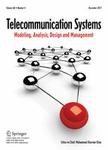版权所有:内蒙古大学图书馆 技术提供:维普资讯• 智图
内蒙古自治区呼和浩特市赛罕区大学西街235号 邮编: 010021

作者机构:Univ Carlos III Madrid Avda Univ 30 Leganes 28911 Spain Telefonica Espana Calle Gran Via 28 Madrid Spain
出 版 物:《TELECOMMUNICATION SYSTEMS》 (Telecommun. Syst.)
年 卷 期:2016年第61卷第1期
页 面:59-76页
核心收录:
学科分类:0810[工学-信息与通信工程] 0809[工学-电子科学与技术(可授工学、理学学位)] 08[工学]
基 金:Spanish Ministry of Science and Innovation [TEC2010-20572-C02-01] State of Madrid (Spain) [S2009/TIC-1650]
主 题:Transcoding Content protection keyword Cloud computing
摘 要:Video coding is a process for adapting media content to the constraints of transmission networks delivery and terminal device visualization. Moreover, content protection is also necessary. Nowadays the heterogeneity of client devices is increasing leading to different resolutions, qualities and form factors. Due to this, transcoding and protection are essential processes to be conducted in modern video distribution networks to adapt video to devices and network constraints and to enable pay per quality schemas enforcing content licenses. Unfortunately, transcoding and protection can be no longer considered linear since every single content should be transcoded in several formats and sometimes protected, so it would require a long time to finish. Modern scalable coding techniques, as H264 SVC, can help to save processing power and bandwidth providing in a single stream several video versions. However, if the enhancements of a SVC encoded content are protected separately, it would possible to enable pay-per-quality providing an additional degree of freedom to content delivery industry. Unfortunatelly, transcoding and protection entail huge doses of processing power at provider side and should be distributed. Moreover, processing key streams to decrypt enhancements that were encrypted separately can increase the complexity at receiver side. Cloud computing emerges as a potential solution for coping with large population of users with heterogeneous visualization devices. The elastic nature of cloud computing can be an advantage given the difficulty to predict the computing resources video content would require to be distributed during the entire content life. This article describes a system that distributes and parallelizes the video transcoding process as well as the content encryption, following the SaaS approach in cloud computing. Moreover, the article describes an experimental approach for generating and processing a flexible key stream that would help to simplify